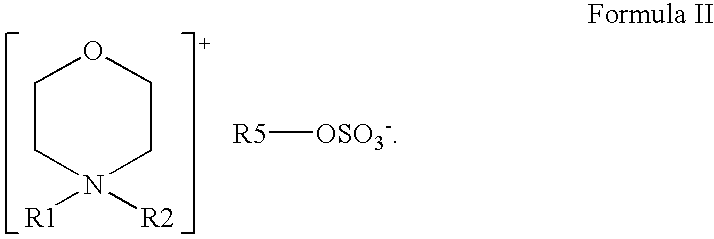Reduction of odors in absorbent articles
a technology of absorbent articles and odor reduction, which is applied in the direction of liquid/solution decomposition chemical coating, superimposed coating process, manufacturing tools, etc., can solve the problems of unhealthy and unpleasant inhalation of malodorous gases emanating from used absorbent hygiene articles, time-consuming and laborious, and inability to produce ammonia in significant quantities, etc., to achieve the effect of reducing the malodor of bodily fluids
- Summary
- Abstract
- Description
- Claims
- Application Information
AI Technical Summary
Benefits of technology
Problems solved by technology
Method used
Image
Examples
example 1
[0071] Four absorbent structures containing 4.5 g of fluff pulp from grade RAYFLOC® JLD-E, made by Rayonier Inc., and 1.5 g of SAP from grade AQUAKEEP® SA55S, made by Sumitomo Seika Chemicals Co., Ltd. (Japan), are prepared. The first structure is sprayed with 4.5 ml of water and is designated as the control. The other three are sprayed with 4.5 ml of an aqueous solution containing 1% FORESTALL, obtained from Uniqema (Wilmington, Del.). FORESTALL is the tradename for 4-ethyl-4-soya morpholinium ethyl sulfate, an additive that has the chemical characteristics of the invention. The samples are allowed to dry and are then transferred to 125-ml Erlenmeyer flasks.
[0072] A healthy human donor provides about 150-250 ml of fresh urine in a collection cup. The urine is divided into four equal volumes and is then distributed equally to each of the four samples. The flasks are then sealed with the stopper / detection tube assembly and placed in the water bath set at 37° C.
[0073] Table 1 contai...
example 2
[0075] Samples of treated SAP are prepared in 600 ml beakers. A solution containing 0.9% NaCl is made, and 600 ml of solution is added to each beaker. FORESTALL in the quantity of 0.135 g is dissolved in one of the beakers, while another beaker does not contain this additive. SAP as grade HySorb P-8400 is obtained from BASF Corporation. Now, 13.5 g of SAP is added to each beaker and stirred. The swollen SAP samples are then put into a convection oven set at 110° C. and are allowed to dry for about 48 hours. After drying, the samples are allowed to equilibrate at room temperature for about 30 minutes. The samples are then crushed at a pressure of 1 psi and scraped out of the beakers. The recovered particles are then milled in a coffee grinder and placed into a plastic vial. The vials are labeled with the quantity of the treatment added to the beakers or are labeled as controls if no additives were included.
[0076] Four absorbent structures containing 4.5 g of fluff pulp from grade RA...
example 3
[0078] Four absorbent structures containing 4.5 g of fluff pulp from grade RAYFLOC® JLD-E, made by Rayonier, and 1.5 g of SAP from grade AQUAKEEP® SA55S, made by Sumitomo Seika Chemicals Co., Ltd. (Japan), are prepared. The first structure is sprayed with 4.5 ml of water. This sample is designated as the control. Onto the other three structures, 4.5 ml of an aqueous solution containing 1% ARQUAD HTL8-MS is sprayed. ARQUAD HTL8-MS is the tradename for hydrogenated tallowalkyl(2-ethylhexyl)dimethylammonium methyl sulfate, an example of the treatment of this invention. This chemical is manufactured by Akzo Nobel Chemicals, Inc.
[0079] Table 3 contains the data measured.
TABLE 3Ammonia Concentration ppm-hour8 hour24 hour32 hour48 hourreadingreadingreadingreadingC125300>500T12550100T22270100T3204050Donor XC202540500T40121540T50151540T6051025Donor YC3075200>500T70252550T80252550T90252550Donor X
[0080] As seen from the data, the treatment meets the criteria of the invention.
PUM
| Property | Measurement | Unit |
|---|---|---|
| volumes | aaaaa | aaaaa |
| pressure | aaaaa | aaaaa |
| temperature | aaaaa | aaaaa |
Abstract
Description
Claims
Application Information
 Login to View More
Login to View More - R&D
- Intellectual Property
- Life Sciences
- Materials
- Tech Scout
- Unparalleled Data Quality
- Higher Quality Content
- 60% Fewer Hallucinations
Browse by: Latest US Patents, China's latest patents, Technical Efficacy Thesaurus, Application Domain, Technology Topic, Popular Technical Reports.
© 2025 PatSnap. All rights reserved.Legal|Privacy policy|Modern Slavery Act Transparency Statement|Sitemap|About US| Contact US: help@patsnap.com



